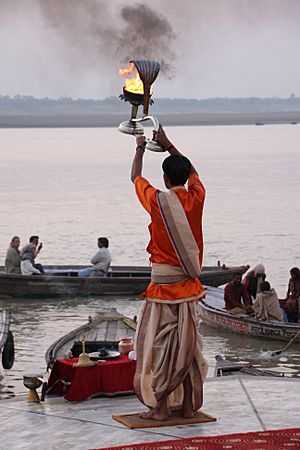Aarti facts for kids

Aarti, also spelled arti, arati, arathi, or aarthi (in Devanagari: आरती ārtī), is a special Hindu religious ritual. It's a way for people to show their love and respect to gods and goddesses. During Aarti, worshippers offer light, often from lamps or candles, and sing beautiful songs of praise. It's a very important part of many Hindu ceremonies and daily prayers.
Contents
What is Aarti?
Aarti is a ceremony where light is offered to deities (gods or goddesses). This light usually comes from wicks soaked in oil or ghee (clarified butter), placed in a special lamp. The lamps are often arranged on a tray, sometimes with flowers, incense, and other offerings.
Why is Aarti Performed?
People perform Aarti to express their devotion and gratitude to the divine. It's believed that by offering light, they can remove darkness and bring in positive energy. The light symbolizes purity, knowledge, and the presence of God. It's also a way to thank the deities for their blessings.
The Meaning Behind the Light
The light in Aarti represents the divine light that shines within everyone and everything. It reminds people that God is everywhere and is the source of all light and life. Offering this light is a way of saying, "Everything I have comes from you, and I offer it back to you."
How is Aarti Performed?
Aarti is usually performed by moving a lit lamp in a circular motion in front of a deity's image or statue. As the lamp is moved, devotional songs, called Aarti songs or bhajans, are sung. These songs praise the deity and express feelings of love and surrender.
The Aarti Plate
A special plate, called an Aarti Thali, is often used. This plate holds the lit lamps, along with other items like:
- Flowers, which symbolize beauty and purity.
- Incense sticks, which create a pleasant fragrance and purify the air.
- Conch shells, which are blown to create a sacred sound.
- Small bells, which are rung to invite the divine presence.
- Water, which represents purity.
The Circular Motion
The circular motion of the lamp is very symbolic. It represents the cycle of life, the movement of the planets, and the continuous flow of divine energy. It also shows that the worshipper's entire being is focused on the deity.
When is Aarti Performed?
Aarti can be performed at different times:
- Daily: Many Hindu homes and temples perform Aarti every morning and evening.
- Festivals: It's a major part of celebrations like Diwali, Durga Puja, and Ganesh Chaturthi.
- Special Occasions: Aarti is also performed during weddings, housewarmings, and other important events.
Different Types of Aarti
While the basic idea of offering light remains the same, Aarti can vary:
- Temple Aarti: Grand ceremonies performed by priests in temples, often with many lamps and musical instruments.
- Home Aarti: Simpler versions performed by families in their homes.
- River Aarti: Famous Aartis are performed on the banks of sacred rivers like the Ganges, where lamps are floated on the water.
The Experience of Aarti
Attending an Aarti ceremony can be a very powerful and peaceful experience. The combination of the flickering lights, the fragrant incense, the ringing bells, and the beautiful singing creates a spiritual atmosphere. Many people feel a deep connection to the divine during Aarti.
Receiving Blessings
After the Aarti is performed, the worshippers often pass their hands over the flame and then touch their eyes or head. This act is believed to transfer the blessings and positive energy from the flame to the person. It's a way of receiving the divine light and wisdom.
Images for kids
-
Taking arti blessing during a Durga puja celebration.



